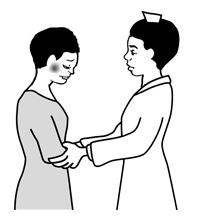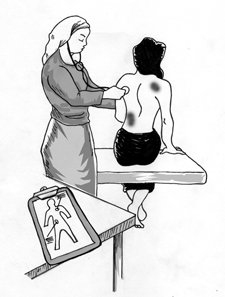What Can Providers Do?
1. Help women feel welcome, safe, and free to talk.
Help women feel comfortable speaking freely about any personal issue, including violence. Ensure every woman that her visit will be confidential.
Give women opportunities to bring up violence, such as asking a woman about her partner's attitudes toward her using family planning, asking whether she foresees any problems with using family planning, and asking simply if there is anything else she would like to discuss.
2. Ask women about abuse whenever violence is suspected.
While most women will not bring up that they are being abused, many will talk if asked about violence. Asking all clients if they are experiencing violence is recommended only when providers are well-trained in counseling about violence, privacy and confidentiality can be ensured, and there are sufficient resources available to respond adequately to identified cases of violence. Until then, providers can ask whenever abuse is suspected, thereby focusing resources on those who need immediate care.
Be alert to symptoms, injuries, or signs that suggest violence. Providers may suspect violence when depression, anxiety, chronic headaches, pelvic pain, or vague stomach pains have not improved over time with treatment. Another sign of violence may be when the client's story about how an injury occurred does not fit the type of injury she has. Suspect violence with any injury during pregnancy, especially to the abdomen or breasts.
Some tips for bringing up the subject of violence:
- To increase trust, explain why you are asking—because you want to help.
- Use language that is comfortable for you and best fits your own style.
- Do not ask such questions when a woman's partner or anyone else is present or when privacy cannot be ensured.
- You can say, "Domestic violence is a common problem in our community so we have been asking our clients about abuse."
- You can ask such questions as:
- "Your symptoms may be due to stress. Do you and your partner tend to fight a lot? Have you ever gotten hurt?"
- "Does your partner ever want sex when you do not? What happens in such situations?"
- "Are you afraid of your partner?"
3. Counsel in a nonjudgmental, sensitive, supportive manner.
An important service for women in violent relationships is counseling. Counseling about violence should be tailored to a woman's particular circumstances. Women may be at different stages of willingness to seek change.  This will affect whether and how a woman will accept help. Some women will not be ready to discuss their situation with a health care provider. The point of counseling is not to find out for sure whether the client is experiencing violence, but rather to address the issue with compassion and let her know that you care.
This will affect whether and how a woman will accept help. Some women will not be ready to discuss their situation with a health care provider. The point of counseling is not to find out for sure whether the client is experiencing violence, but rather to address the issue with compassion and let her know that you care.
- If she does not want to talk about the violence, assure her that you are available whenever she needs you. Tell her what options and resources are available should she ever want them.
- If she wants to talk about her experience of violence, you can:
- Ensure confidentiality, and keep the woman's situation confidential. Tell only those who need to know (such as security staff), and do that only with the client's permission.
- Acknowledge her experience. Listen, offer support, and avoid making judgments. Respect her ability and her right to make her own choices about her life.
- Try to relieve the woman's possible feelings of shame and self-blame: "No one ever deserves to be hit." "You don't deserve the abuse, and it's not your fault."
- Explain that violence is a common problem: "This happens to many women." "You are not alone, and help is available."
- Explain that violence is not likely to stop on its own: "Abuse tends to continue, and often it becomes worse and happens more often."
4. Assess a woman's immediate danger, help her develop a safety plan, and refer her to community resources.
If the woman faces immediate danger, help her consider various courses of action. If not in immediate danger, help her develop a longer-term plan.
- Help her assess her present situation:
- "Is he here at the health facility now?"
- "Are you or your children in danger now?"
- "Do you feel safe to go home?"
- "Is there a friend or relative who can help you with the situation at home?"
- Help her protect herself and her children if the violence recurs. Suggest that she keep a bag packed with important documents and a change of clothes so she can leave quickly if need be. Suggest that she have a signal to let children know when to seek help from neighbors.
- Make and keep up-to-date a list of resources available to help victims of abuse, including police, counseling services, and women's organizations that can provide emotional, legal, and perhaps even financial support. Give a copy of the list to the client.
5. Provide appropriate care.
Tailor your care and counseling to a woman's circumstances.
- Treat any injuries or see that she gets treatment.
- Evaluate risk of pregnancy and provide emergency contraception if appropriate and wanted.
- Offer emergency contraceptive pills for future use (see Emergency Contraceptive Pills).
- If she wants, give her a contraceptive method that can be used without a partner's knowledge, such as an injectable.
- Help women think about whether they could safely propose condom use, without risking further violence.
- In cases of rape:
- First collect any samples that could be used as evidence (such as torn or stained clothing, hair, and blood or semen stains).
- Provide or refer for HIV and STI testing and treatment. Some women may need such services repeatedly.
- Consider post-exposure prophylaxis for HIV, if available, and presumptive treatment for gonorrhea, chlamydia, syphilis, and other, locally common STIs.
6. Document the woman's condition.
Carefully document the woman's symptoms or injuries, the cause of the injuries, and her history of abuse. Clearly record the identity of the abuser, his relationship to the victim, and any other details about him. These notes could be helpful for future medical follow-up and legal action, if taken.

 Previous Chapter
Previous Chapter  Previous Page Next Page
Previous Page Next Page  Next Chapter
Next Chapter 


 Previous Chapter
Previous Chapter Previous Page
Previous Page

 This will affect whether and how a woman will accept help. Some women will not be ready to discuss their situation with a health care provider. The point of counseling is not to find out for sure whether the client is experiencing violence, but rather to address the issue with compassion and let her know that you care.
This will affect whether and how a woman will accept help. Some women will not be ready to discuss their situation with a health care provider. The point of counseling is not to find out for sure whether the client is experiencing violence, but rather to address the issue with compassion and let her know that you care.